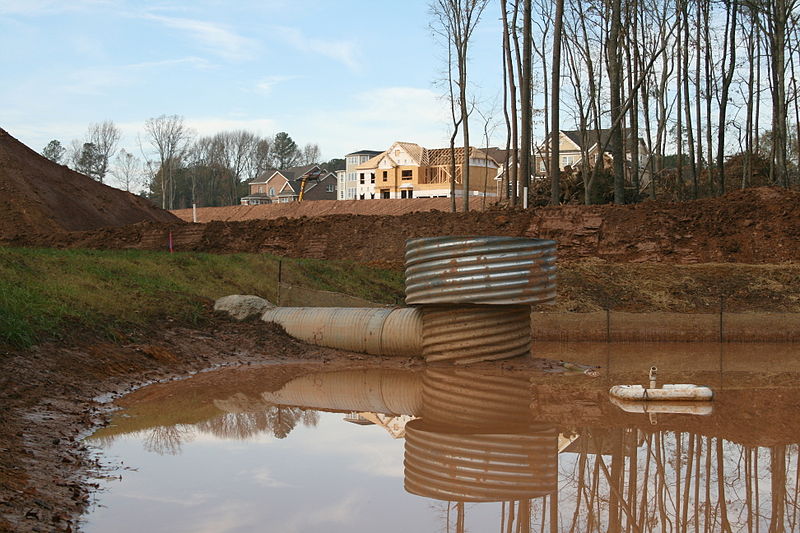While you may not control when or how often it rains, there are steps you can take to reduce the impact rainwater has on your property. Water can build in your yard without drainage, causing structural difficulties with your home, damage to plants and flowers, an increase in bugs, and a muddy mess. The following are signs that you may have inadequate drainage:
- The basement has water.
- Mosquito larvae breed in puddles of water.
- Suffocating/drowning grass, trees, and plants
- Erosion
Photo Courtesy: Wikimedia Commons
One nighttime typhoon is all it takes to throw your home’s plumbing into shambles. A well-functioning drainage system is essential to the plumbing anatomy of your home and your financial well-being.
RELATED: Kitchen Sink Not Draining? Here are 5 Methods to Unclog It
Let’s take a look at seven of the most frequent property drainage issues and how to fix them:
1. Runoff from neighbors
Higher-elevation erosion is a huge issue, and it happens when you live downhill from adjacent homes. This erosion isn’t your neighbors’ fault, but you can’t ask them to stop it either. During a downpour, the best thing to do is to observe how the water flows into your yard. The water diverts by constructing a berm or swale or rerouting it to a catch basin or dry well. You can also hire a professional landscaper to grade large surfaces.
2. Landscaping issues
It’s tough to accept that your hard work causes the issues, but it’s plausible. A yard that slopes toward your home, bare soil without plants, or paved surfaces that drive water to the structure are all potential issues. Unfortunately, not everyone considers these factors when undertaking house improvements. The goal is to redirect the water, possibly with drains or other creative alternatives such as gravel and rocks.

Photo Courtesy: Pixabay
People use too much topsoil or mulch in their planting beds or have an incorrect grade when they are on the ground. They rise and slant back toward the house, forcing water to stream back and forth against or into the structure. If the gutters overflow as well, you’ve got a severe problem. Ensure the planting beds’ grade is away from the house or structure.
3. Roots in your drainage pipes
Pipes cause drainage issues. If your drains are backing up, it’s because the problem isn’t a crushed or damaged pipe but instead roots that have infiltrated the line. They may squeeze into joints and swiftly expand, shattering the fitting and consuming all the moisture in the drainage pipe.
They not only obstruct but fill the tube in a short period, causing pipe removal or the use of a root cutting service to come in and mechanically precise the line out. Occasionally, you can find perforated pipe in shallow areas or among trees. This pipe allows grassroots or tree roots to locate a moisture source and infiltrate the pipe quickly.
After cleaning the line of seeds, make sure the perforated wrapped pipe is in filter fabric, and the seams are there to prevent roots from entering the tube.
4. overflowing gutters and downspouts
When it rains the next time, step outside and observe how the system handles the water. This problem could be a plumbing issue if rain is spilling over the edge of the gutters. It’s also possible that water is gathering around the downspout. Have your gutters cleaned carefully to remedy the problem.

Photo Courtesy: Wikimedia Commons
Use corrugated pipes that run beneath the soil to deflect water away from downspouts. This solution also helps move water that has become too saturated in the ground.
5. Issues with grades
When dealing with a grading issue, it is best to consult a specialist. The severity of a grading problem influences the complexity of resolving it. For example, a specialist may suggest installing a new drainage system to best suit the home’s plumbing.
6. Clogged soil in water
The ground becomes naturally water blocked if your home has a large roof or a long driveway that pours water into the yard. When dealing with this plumbing issue, you have a few options, and if you have a green thumb, be creative.
One way to get rid of excess water in the yard is to use moist plants. Because they soak up a lot of water, these plants flourish in damp environments. Build a rain garden on your property if this sounds appealing.
Consider installing an underground drain parallel to your home’s driveway for a faster solution. This drain helps to keep runoff to a minimum.
7. Flooding
When dealing with interior flooding, regrading your house might also help. Installing an underground drain to gather water away from your foundation is another way to fix a flooding problem.

Photo Courtesy: Flickr
A swale is also a tool to divert water away from your home. Typically, a grassy or rocky swale is the tool, and they’re handy since, unlike piping, they fit in with your property.
RELATED: 5 Simple Ways to Prevent Your Toilet from Clogging
Fix the problem right away!
Follow these tips right away if you have water drainage problems. Postponing fixing the issue will create more damage to your property. It’s better to get rid of a minor problem fast before it becomes too much to handle.
Want to see more content like this in the future? Subscribe now!
CITATIONS:
- “7 Common Property Drainage Problems and How to Resolve Them.” Horizon Landscape Company, 20 June 2014, horizonlandscape.com/7-common-property-drainage-problems/.
- dsldland. Drainage Problems and Solutions. 1 Oct. 2018, www.dsldland.com/drainage-problems-and-solutions/.
- “How to Solve 4 of the Most Common Drainage System Problems.” Www.warnerservice.com, www.warnerservice.com/the-most-common-home-drainage-system-problems.
![]()









